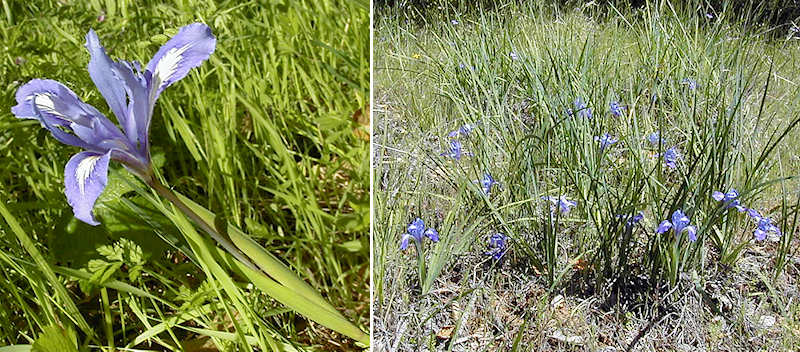Wild PCN iris - long tube group (5 species), spathes enclose ovary:
4. Bowl tube iris - Iris macrosiphon

Photos: (L & R) Iris macrosiphon - Soda Canyon Road, Napa County, California. Steve Ayala

Range: Widespread in central California's coastal ranges and facing Sierra Nevada foothills; south to Mariposa and Santa Cruz counties; north of the Great Central Valley replaced by I. tenuissima. Near sea level to around 3,000 feet elevation.
Original material: Corte Madera, Marin County, California 1854.
Key identifying features:
- Long floral tube; 1½ to 4½ inches.
- Spathes narrow, closed, enclosing ovary and lower tube.
- Top of tube abruptly bowl-shaped; petals separate around bowl's rim.
- Stems unbranched, single or double flowered.
- Plants usually individual, or in small clumps.
Flower color: Wide color spectrum: usually lavender or lilac-purple with a white signal spot and darker veins. Outside the area where originally described (Marin County) sometimes cream, yellow or white. Local populations tend to show variations of a single color pattern.
Habitat: Sunny, open oak and pine woodland sites, grasslands or meadows with filtered or no shade. Replaced by other species in adjacent, more shaded habitats. Clumps develop when seeds from several generations fall in the same plot.
Name: By Professor John Torrey, for the long floral tube (macro = large + siphon = tube) these iris.
Comments: "Ground iris" is another common name for Iris macrosiphon. In some regions plants growing in full sun often develop close to the ground and their flowers sometimes have very short stems. The name "Long tube iris" is also seen - but that name could as well be applied to any of the five Pacifica iris in the long-tube group.
Like Iris tenax in Oregon, this species has two strong fibers that extend along the edges of each leaf. For centuries before European settlement, local California peoples used ground iris fibers as a source of cordage for thread, string, nets, ropes and such.
Iris macrosiphon is widely distributed, comprising a mosaic of many distinctive local populations, each with its own long, separate and unique history. Its range overlaps nearly all the other California PCI species, and over millennia, most have surely contributed to the genetic makeup of today's bowl tube iris populations.
In past decades some local populations were assigned their own varietal or subspecific names. But Iris macrosiphon shows so much variation, with features that grade into each other, that no one has yet been able to satisfactorally identify distinct, consistent subgroups.
The picture is further confused by book and magazine articles that used the name "macrosiphon" for misidentified individuals of other long-tube species, especially I. fernaldii and I. tenuissima. And sometimes true macrosiphon is found labeled with some other name, like Iris hartwegii. In I. macrosiphon, the ovary is almost always well hidden inside the two spathes, and unlike I. fernaldii or I. tenuissima, the petals and sepals separate close along the rim of a bowl-like swelling at the top of the long floral tube.
It is still unclear how far north I. macrosiphon extends in the outer Coastal Ranges into northwest California, especially in areas where it comes into contact with other long floral tube species like Iris tenuissima and possibly Iris chrysophylla. Long, upward-curving style crests like those of the other two species have not been reported for Iris macrosiphon.
Additional Photos: